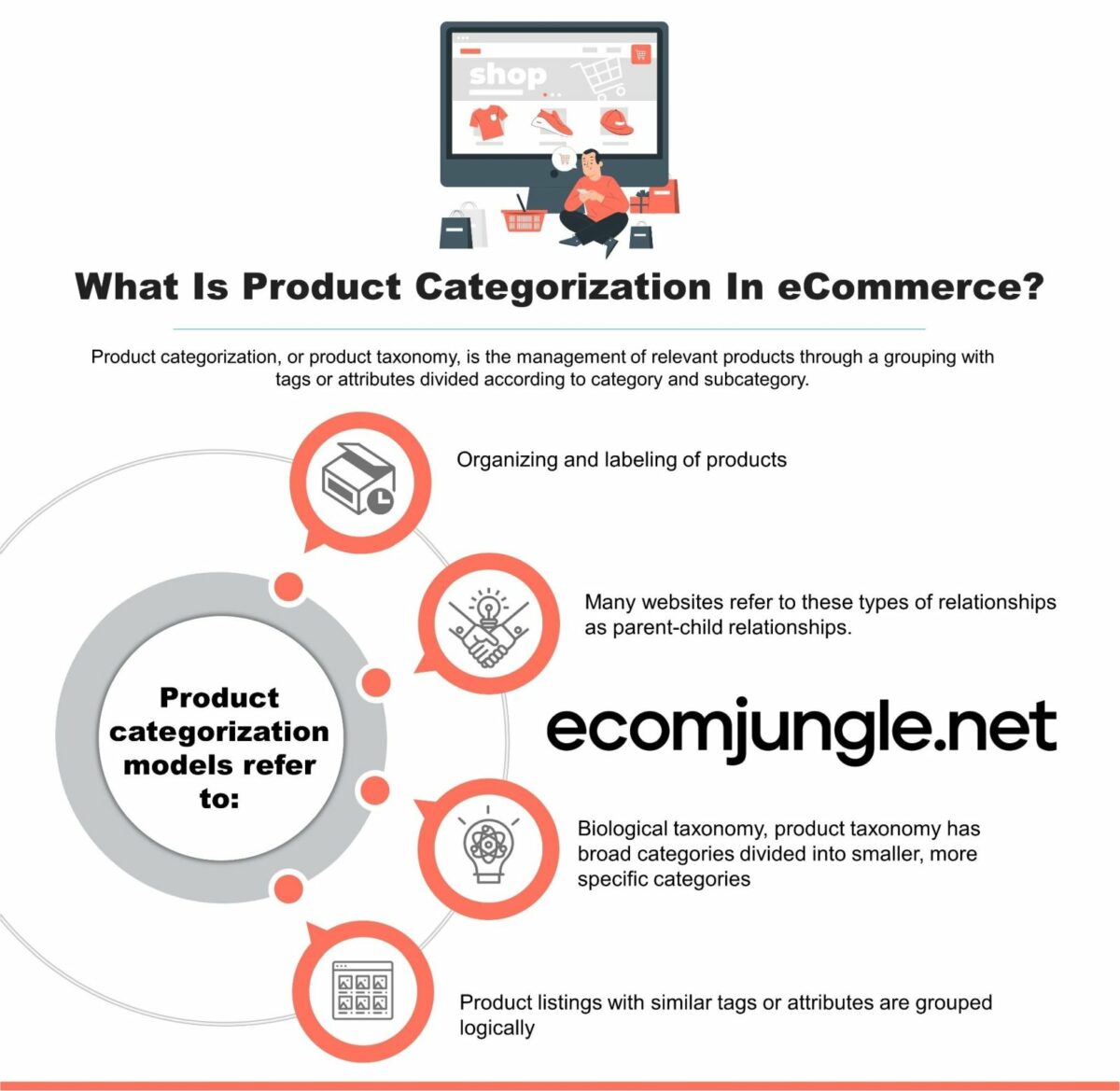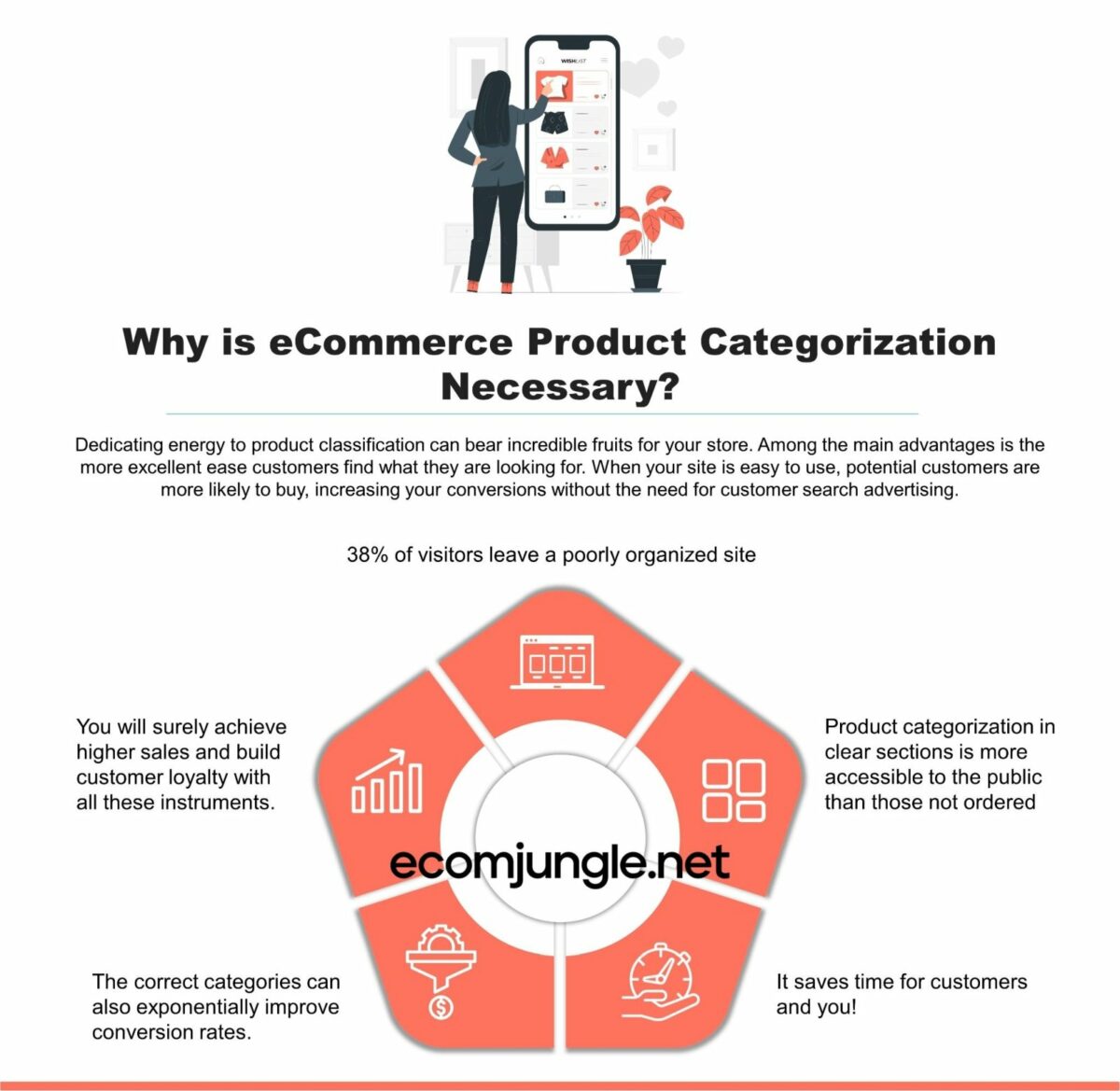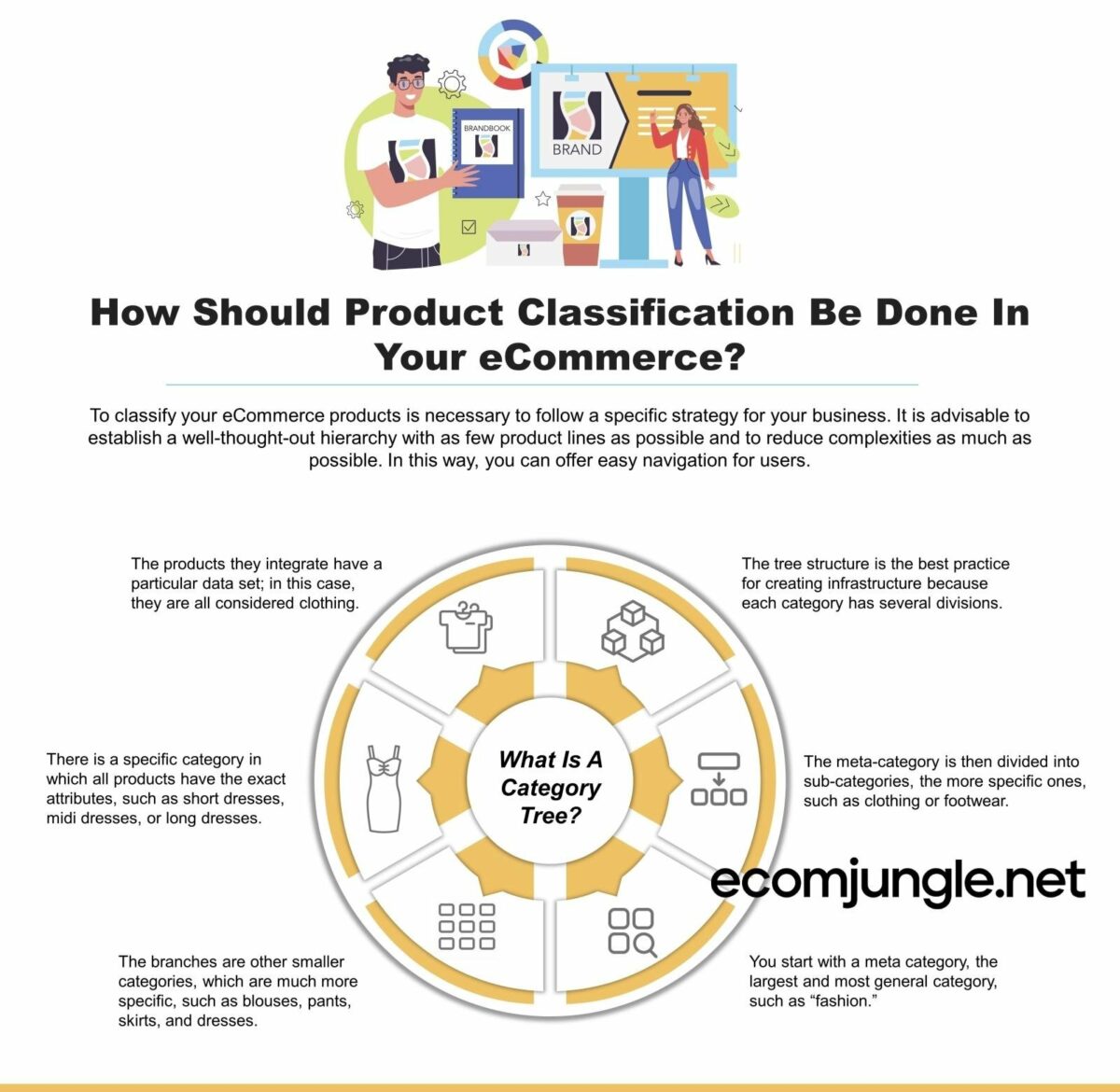Easy navigation and search functionality are essential for any e-commerce site to provide great UX and increase conversion rates. Users who are clear about what product they want often use the magnifying glass or search function to find what they want quickly. Other users often use drop-down menus, and the filters available in some online stores in the top navigation or sidebars.
Due to the high relevance of navigation in an eCommerce store, it is crucial to understand multiple categories and tags and how you should implement them to achieve higher sales.
In this article, I will delve into the topic to help you understand everything about product categorization and how to implement it in your eCommerce.
Let’s talk about it!
- What Is Product Categorization In eCommerce?
- Why is eCommerce Product Categorization Necessary?
- How Should Product Classification Be Done In Your eCommerce?
- What Is A Category Tree?
- How Many Levels Should The Category Tree Have?
- How Can A Leaf Category Be Recognized?
- Things To Avoid In Product Categorization
- Essential Considerations For Product Organization
- Frequently Asked Questions
- Conclusion
What Is Product Categorization In eCommerce?

Product categorization, or product taxonomy, is the management of relevant products through a grouping with tags or attributes divided according to category and subcategory.
In short, product categorization models refer to the organizing and labeling of products in any related system according to their relevance.
As in biological taxonomy, product taxonomy has broad categories divided into smaller, more specific categories. In each category, product listings with similar tags or attributes are grouped logically. For that reason, many websites refer to these types of relationships as parent-child relationships.
For example, imagine going to a grocery store; finding milk in the dairy aisle is logical. The same thing happens in an online store; to find a suitable lamp for your workspace, in a large company like Walmart or Target, you first look in the furniture section. Then select a certain category more specific to your needs, such as Office Furniture and Accessories. All this organization is essential to make it easier for customers find what they want.
The hierarchy of products must be intuitive; otherwise, it would be difficult for shoppers to search for relevant products. However, to make it intuitive the product categorization, you must make several configurations and overcome several challenges. But I assure you that it is worth overcoming them because the creation and proper maintenance of a product hierarchy are crucial for the growth of any eCommerce business.
Did you know about it?
Why is eCommerce Product Categorization Necessary?

Dedicating energy to product classification can bear incredible fruits for your store. Among the main advantages is the more excellent ease customers find what they are looking for. When your site is easy to use, potential customers are more likely to buy, increasing your conversions without the need for customer search advertising.
According to Adobe, 38% of visitors leave a poorly organized site because they have difficulty finding what they want. Product categorization in clear sections is more accessible to the public than those not ordered. In other words, it saves time for customers and you!
The consequence of this is to improve the customer experience of your online store. A well-organized catalog allows them to find the products they want and even discover others they weren’t even looking for in just a few clicks.
The correct categories can also exponentially improve conversion rates. The more satisfied the customer is with the experience offered by your store, the more likely they are to complete the purchase. And here, speed and ease are decisive factors for the purchase.
You will surely achieve higher sales and build customer loyalty with all these instruments. Therefore, good product categorization is essential for your store’s success in e-commerce.
Are you ready to learn to categorize products on an eCommerce website from scratch? Read on!
How Should Product Classification Be Done In Your eCommerce?

To classify your eCommerce products is necessary to follow a specific strategy for your business. It is advisable to establish a well-thought-out hierarchy with as few product lines as possible and to reduce complexities as much as possible. In this way, you can offer easy navigation for users.
Pro Tip:
Start forming a product taxonomy or product categorization with the product data, which will be the framework in which all data will be organized. Then it would help if you made updates to fine-tune the product taxonomy regularly.
What Is A Category Tree?
The tree structure is the best practice for creating infrastructure because each category has several divisions. In such a structure, you start with a meta category, the largest and most general category, such as “fashion.” The meta-category is then divided into sub-categories, the more specific ones, such as clothing or footwear.
Below the branches are other smaller categories, which are much more specific, such as blouses, pants, skirts, and dresses. The products they integrate have a particular data set; in this case, they are all considered clothing. Then there is a specific category in which all products have the exact attributes, such as short dresses, midi dresses, or long dresses.
In addition, the tree structure ensures that each leaf category belongs to the same target or branch category. Grouping a branch category into two or more meta-categories is difficult because each sub-category “inherits” the characteristics of its parents. Therefore, it isn’t easy to establish which categories each branch should receive in the product categorization.
Are you applying this structure?
How Many Levels Should The Category Tree Have?
Based on my experience, I can say that the ideal number of levels to divide the category levels into is three levels. You can achieve the breadth you need in the meta category and each subcategory with three levels. It also allows you to easily manage the tree structure, i.e., add or remove categories. When there are only one or two levels of categories, you group too many products, making it difficult for customers to find what they are looking for.
Therefore, if you want a more efficient structure, you should create a structure with three levels. Although having four or five in your tree structure may seem necessary. You should avoid spreading yourself too thin and limit your category structure to only three levels to avoid disasters. It would help if you considered that the more levels your web page has, the harder it will be for Google or other search engines to crawl the page.
Meta or branch categories
The product classification in the main menu are grouped according to the branch category assigned to the store. The branch category is a container for the main menu within the category tree. Therefore, you can create a root category with an entirely new set of products or copy the products from an existing branch category.
Main categories
More extensive groupings of products are called main categories. The purpose of this type of category is to provide visitors with a full scope of what the store offers quickly and easily.
For example, suppose your potential customer is interested in buying a rear bumper. The main or broader categories are bumpers, floor mats, lighting, and other cosmetic car accessories. In that case, they will select the “Bumper” option and thus quickly find what they need without much effort.
However, if you have this same variety of main categories on the store website, but your customer is interested in buying wholesale electronic components. You have them available in your store, but the “electronics” section is not on your list of categories. Visitors will visit one of your competitors’ websites because they think you only sell cosmetic accessories.
That’s how easily you can lose a sale!
Pro Tip:
Each product group should have a “main-category” assignment at the top of the tree. Also, you should indicate at the same time what you have or don’t have in stock to guide the customer intuitively on the right path.
Subcategories
The main category is broken down into more specific groups of products; in the subcategories, potential customers can compare and select the products they want to buy.
I recommend limiting yourself to setting up only one or two subcategory levels, so you can stay within the framework of only needing three clicks to buy. This varies if you have extensive inventories.
For example, in an automotive store, you might break down the “bumper” category into the front bumper or rear bumper and floor mats into a list of brands or compositions, depending on how you choose to present the product descriptions.
In the case of a clothing store, you can divide the general category of women’s clothing into dresses, T-shirts, and pants, jeans, among others.
Generally, it is considered anticipated to reference product data such as size, design, and material at the subcategory level, as listing these types of variables in the main navigation is considered overwhelming to most people.
The goal of making a proper product grouping is to attract customers, then allow them to select from the size and material options to purchase the exact product they are interested in.
Feature Categories
Feature categories are unique groupings with attributes that differ from the standard range used for main categories and subcategories. For example, top quality or discounted sale items, limited edition product range, best sellers, and new collections.
We recommend that you do not use all of these classifying products not to confuse your audience and devalue the range of products you offer. Carefully choose the most suitable and convenient ones for your business based on those used by other businesses in your niche.
It may be helpful to distribute these particular categories in the main navigation with designations such as “discount items” to catch people’s attention. If you wish, you can place some permanent links such as “best sellers” or “new collection” in the top search bar or the footer.
Many businesses place these unique categories in a permanent place, visible but not intrusive to users, such as the top header of the web page, which is advisable. This will not create familiarity with your regular customers, so they will most likely regularly review the products you offer in those sections.
How Can A Leaf Category Be Recognized?
Unlike other categories, such as meta and branch, the leaf category does not have other divisions below it. The leaf category can be recognized when all products in the category have similar data sets and can be identified by having the same attributes.
Attributes and values
Attributes and characteristics of eCommerce products help to describe products to customers clearly. Product attributes focus on the product, and feature focus on the customer. They also make it easier to analyze and identify growth opportunities.
Product attributes are the product’s specific characteristics, so they can sometimes be abstract. In contrast, product characteristics are a grouping of multiple attributes that are always abstract.
Product features are not the only thing capable of defining data quality, especially online. Product attributes within e-commerce, as well as display images and descriptions, are of great use in guiding the customer to decide on the purchase.
Product attributes within the e-commerce site are the group of attributes that define a specific category product or even a group of products. Therefore, aspects such as size, color, flavor, and type of packaging, among others, are considered attributes. These attributes are not limited to the general description of the product. Still, they refer to the value that makes them unique.
We can identify the leaf category when we see that all the products in the category have the same characteristics and can be recognized by having the same attributes. Each of the attributes has a list of possible values specific to that same attribute.
The values are expressed as adjectives, so they cannot be used alone in a sentence; they need to describe something, such as a white flannel.
In the size attribute, the options can be: 8, 10, 12, 14, 16, 18, 20.
In the color attribute, the options can be: red, blue, green, white, or black.
Things To Avoid In Product Categorization
The organization of products requires technical knowledge for its correct establishment in product categorization. Therefore, it is essential to know what are the most common mistakes to avoid in the different product categorization models:
1. Repetitions
You must ensure you don’t have redundant categories on your e-commerce site because it can be difficult for users to identify them manually. Therefore force them to search thoroughly through the products. To check if you have duplications, you should analyze if it is possible for a specific item in different categories in the product categorization.
Check for duplications of the same product or duplicate categories, preferably using product categorization tools such as PIM. Analyze the whole taxonomy structure and check the relevant keywords to see if there are repetitions of the same item and correct them.
2. Incorrect identification
Making a wrong product taxonomy in a product categorization is very common, especially if you do not have an automated system dedicated to product hierarchy management. This usually happens if you have a manual and antiquated system. For this reason, system automation is recommended to avoid this type of error, as it is one of the most effective ways to organize product tagging.
3. Omitting categories
When randomly configuring your product hierarchy or product categorization, this error is common; however, it is something you can easily avoid. You should check if any category or subcategory in your e-commerce has an overload of products. Then you can analyze the possible types that can be added to relocate the products in naming conventions.
4. Overcomplication in the product hierarchy
Overcomplication in eCommerce platforms is subjective, so your perception may vary depending on the type of business. Some brands have thousands of total volume SKU items to manage, so they have a lot of variety. In contrast, smaller businesses do not usually present this problem in product categorization.
In some cases, e-retailers often over-categorize unnecessarily, placing too few products in each category. We recommend that if you have more than 15 main product categories in the product categorization, consider rethinking your e-commerce structure.
5. Ignoring SEO
The product hierarchy or product categorization significantly influences SEO evaluation metrics, so it is essential to consider it from the beginning of its configuration. Therefore, categorizing products is worth doing so based on keyword research because this will give you an understanding of how people searching for product categories.
Research the most relevant keywords and check the search-relevant terms for Google taxonomy and other search engine so that they can effectively guide your product categorization. Avoid at all costs that a product is in two different types because this will cause a significant impact on SEO by being considered duplicate content.
In addition, you must pay special attention to the wording and ensure a user-friendly navigation system to reduce the bounce rate as much as possible. But if you want professional results, you can opt for one of the best price product categorization services on the market.
Have you made any of these mistakes?
Essential Considerations For Product Organization
– Create your product categorization in a tree format: when building the infrastructure, you must maintain a tree structure in which the subcategories have a single parent category.
– Three is the key number: Establishing a tree structure in the product categorization with three levels is essential for proper categorization: target category → branch category, → leaf category.
– Recognize when to stop: when you reach the leaf category, you mustn’t create more categories below it not to overload the product categorization.
– Don’t duplicate: form single leaf categories, and make the linkage in the UI to the other meta-categories only when necessary in the product categorization.
Frequently Asked Questions
Product categories in eCommerce are groupings of similar products. Some examples of categories are Fashion (includes Apparel, Cosmetics, Footwear, Handbags, Accessories, Jewelry, etc.), Consumer Electronics, Sporting Goods, Health and Wellness (includes Supplements, Nutraceuticals, etc.), Pets (including Food, Toys, etc.) and Children’s Items (includes Children’s Apparel, Toys, Footwear, etc.).
To facilitate navigation on product pages and minimize the number of clicks users have to make, we recommend that you have no more than 15 level one categories on your e-commerce site and only 2 or 3 category levels. Avoid exceeding the absolute maximum of 5 levels in the product categorization.
Product hierarchy is a method used to classify the products and services of the business according to their essential components to build a logical structure.
The category page in the website hierarchy is located above the product pages. This page is essentially thematic, dedicated to a specific group of products. This makes it easier for the user to navigate by product title, thus helping them to find what they are looking for in the product categorization.
Conclusion
The hierarchical classification of products in eCommerce companies is an elementary part of a business since it is the basis for the display of products. Therefore, creating a product categorization focused on the customer, satisfying their needs, and facilitating access for the business’s success and the customer’s benefit is of utmost importance.
Implement all the tips I discuss in the article to win new customers, offer a better shopping experience, and achieve higher sales rates. If you prefer to get more professional results, you can hire one of the product categorization services offering the best price.
Don’t waste time; start the product categorization as soon as possible!